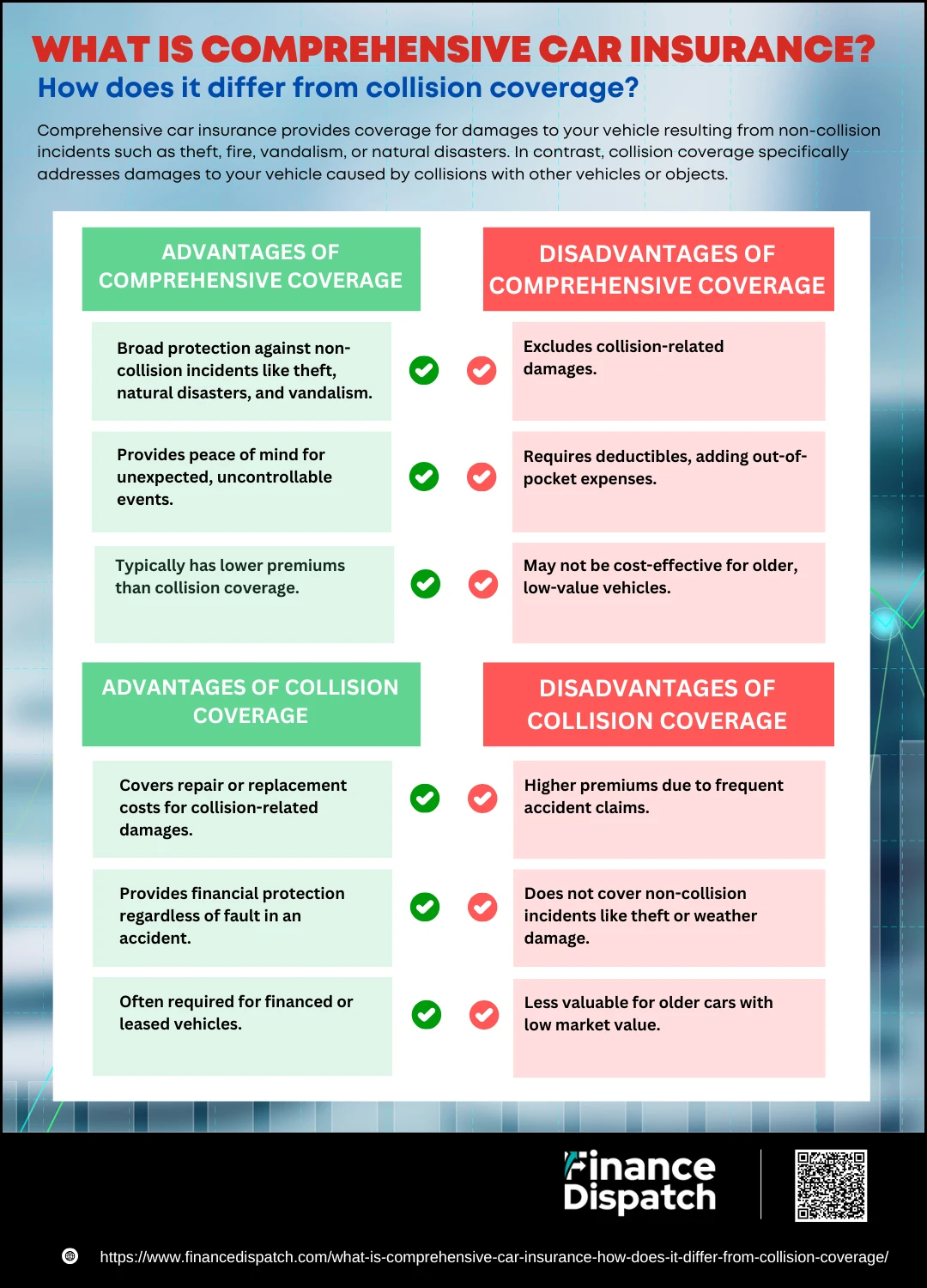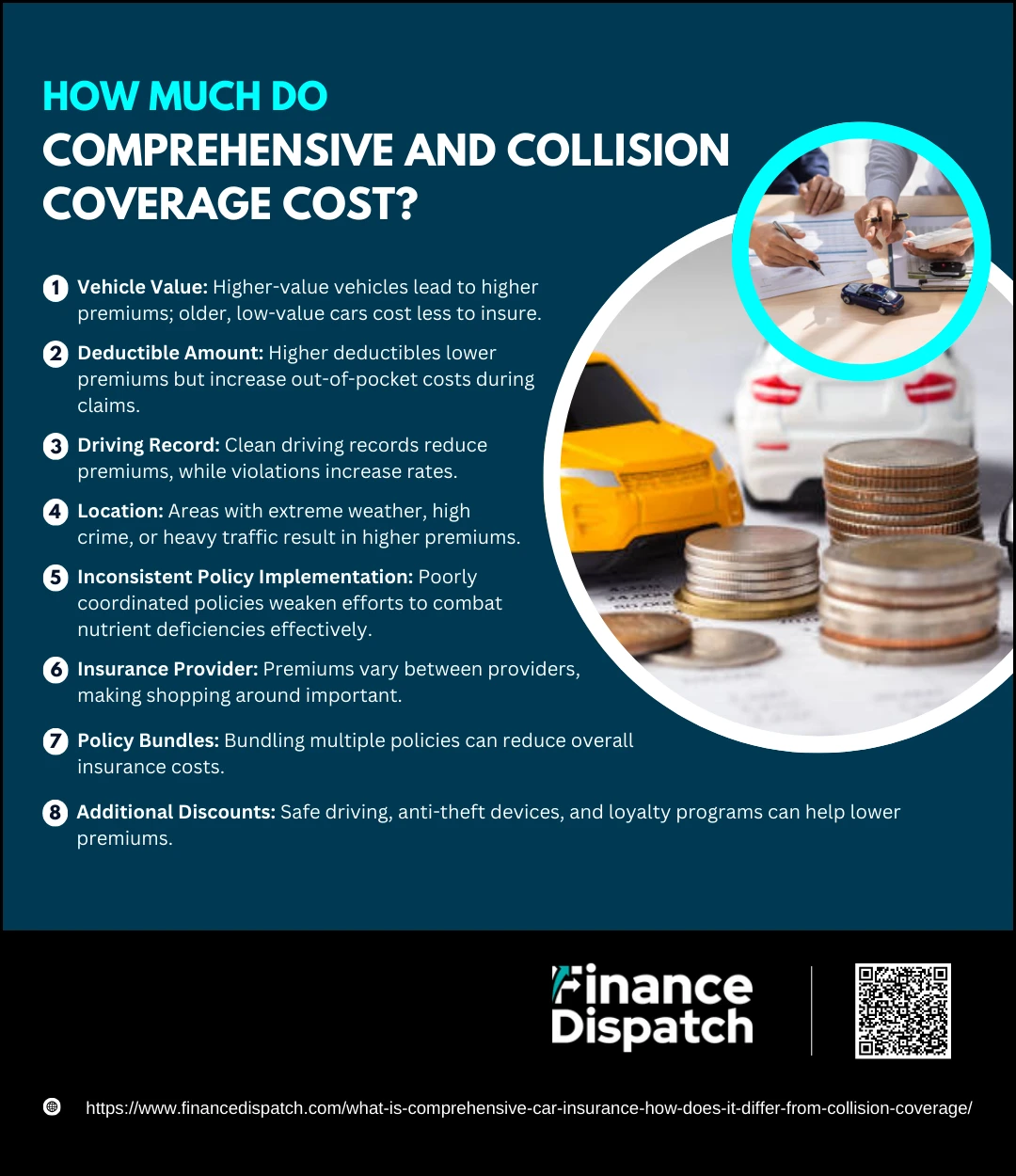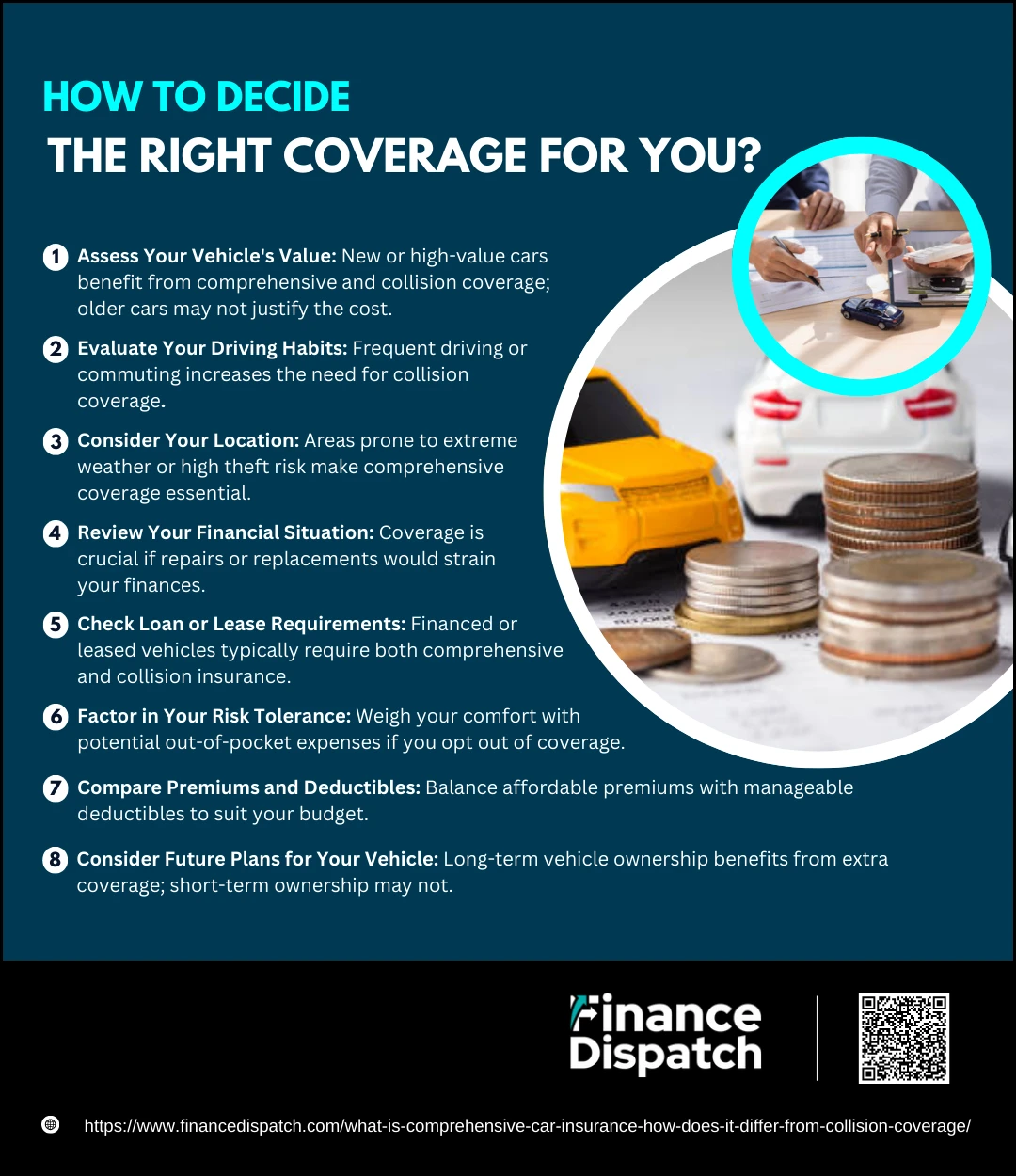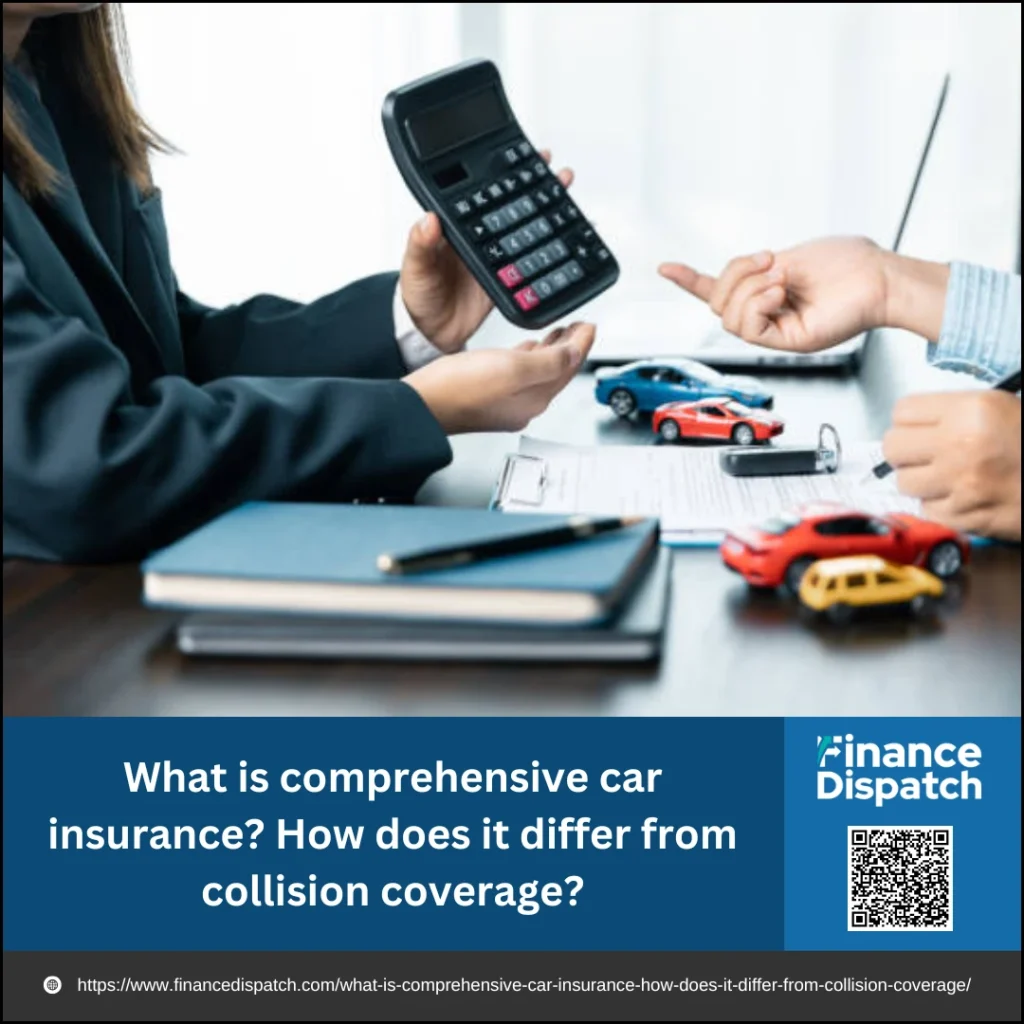When it comes to protecting your car and your peace of mind, understanding the types of auto insurance available is crucial. Comprehensive car insurance and collision coverage are two common options, each serving distinct purposes. While comprehensive insurance safeguards you from non-collision events like theft, vandalism, and natural disasters, collision coverage steps in when your vehicle is damaged in an accident. In this article, we’ll break down what comprehensive car insurance is, how it works, and how it differs from collision coverage, helping you make an informed choice tailored to your needs.
What is Comprehensive Car Insurance?
Comprehensive car insurance is a type of coverage designed to protect your vehicle against damages not caused by a collision. It serves as a safety net for incidents like theft, natural disasters, vandalism, or hitting an animal. For instance, if a tree falls on your car during a storm or your vehicle is damaged in a fire, comprehensive insurance covers the repair or replacement costs. This coverage is often referred to as “other than collision” insurance, as it accounts for unforeseen events that can cause significant damage to your vehicle. While it’s optional in most states, comprehensive coverage is typically required by lenders if your car is leased or financed.
What is Collision Coverage?
Collision coverage is a type of auto insurance that pays for the repair or replacement of your vehicle if it is damaged in an accident, regardless of who is at fault. This includes collisions with other vehicles, objects like fences or poles, or even if your car rolls over. Unlike liability insurance, which covers damages to others, collision coverage focuses solely on your vehicle. It’s especially valuable for protecting your investment in case of an accident, ensuring you’re not left to bear the financial burden of costly repairs or total loss. While optional in many cases, it’s often required by lenders for financed or leased vehicles.
What Does Comprehensive Insurance Cover?
Comprehensive car insurance provides protection for your vehicle against a range of non-collision-related damages. It ensures that you’re covered in situations beyond your control, offering peace of mind when life takes an unexpected turn. Here are some of the key events typically covered by comprehensive insurance:
- Theft: Coverage if your vehicle is stolen or damaged in an attempted theft.
- Natural Disasters: Protection against damages caused by floods, earthquakes, hurricanes, or other natural events.
- Vandalism: Repairs for damages caused by intentional acts, such as graffiti or broken windows.
- Falling Objects: Coverage for damage from objects like tree branches, debris, or rocks.
- Animal Collisions: Repairs if your car is damaged after hitting an animal on the road.
- Fire and Explosions: Protection against vehicle damage caused by fire or explosions.
- Glass Damage: Coverage for broken or cracked windshields and other glass components.
Key Differences between Comprehensive and Collision Coverage
While both comprehensive and collision coverage protect your vehicle, they address different types of risks. Comprehensive insurance covers damages from non-collision incidents like theft or natural disasters, whereas collision coverage applies to accidents involving other vehicles or objects. Understanding these differences can help you decide which coverage suits your needs and financial situation.
| Aspect | Comprehensive Coverage | Collision Coverage |
| Definition | Covers non-collision-related damages. | Covers damages from collisions with vehicles or objects. |
| Primary Focus | Protection from theft, natural disasters, and vandalism. | Repair or replacement of your car after an accident. |
| Claim Scenarios | Examples: Hitting a deer, damage from a hailstorm, or car theft. | Examples: Crashing into another car or hitting a tree. |
| Coverage Requirement | Often optional unless required by a lender. | Often required for leased or financed vehicles. |
| Cost | Generally lower premiums than collision coverage. | Usually higher premiums due to increased risk of claims. |
 Advantages and Disadvantages of Comprehensive and Collision Coverage
Advantages and Disadvantages of Comprehensive and Collision Coverage
Both comprehensive and collision coverage provide valuable protection, but each comes with its own set of benefits and drawbacks. Knowing these can help you make a balanced decision based on your needs, vehicle value, and financial priorities. Here’s a closer look:
Advantages of Comprehensive Coverage
1. Broad Protection: Comprehensive coverage extends to a variety of non-collision incidents that could otherwise result in costly repairs or replacement of your vehicle. This includes events such as natural disasters (e.g., floods or earthquakes), vandalism, or theft, offering well-rounded protection.
2. Peace of Mind: Knowing that your car is safeguarded against unpredictable circumstances, like a falling tree branch or damage from a hailstorm, allows you to focus on daily life without constant worry about repair costs.
3. Lower Premiums: Compared to collision coverage, comprehensive insurance is often more affordable because it addresses events less likely to occur than accidents involving other vehicles.
Disadvantages of Comprehensive Coverage
1. Limited Scope: While comprehensive coverage offers protection against a wide range of scenarios, it specifically excludes damages from collisions. If you’re in an accident, this policy alone won’t cover the costs.
2. Deductibles Apply: Even with comprehensive insurance, you must pay a deductible before your insurer covers the remaining repair or replacement costs. This out-of-pocket expense can sometimes be significant.
3. Optional Nature: For older vehicles with lower market values, comprehensive coverage may not be cost-effective, as the repair costs might exceed the vehicle’s worth.
Advantages of Collision Coverage
1. Accident Repair: Collision coverage ensures that the cost of repairing or replacing your car after a collision is handled, regardless of fault. This can save you thousands of dollars in unexpected expenses.
2. No-Fault Coverage: Whether you’re responsible for the accident or not, this insurance guarantees financial protection for vehicle damages, which can be particularly helpful in no-fault states.
3. Essential for Financed Vehicles: If you’ve leased or financed your vehicle, collision coverage is often a mandatory requirement to protect the lender’s investment in the car.
Disadvantages of Collision Coverage
1. Higher Premiums: Collision insurance is generally more expensive than comprehensive coverage because accidents are more common, and claims are more frequent.
2. Excludes Non-Collision Events: This type of coverage won’t protect you against damages from theft, weather, or other non-collision scenarios, limiting its overall scope.
3. Limited Value for Older Cars: For vehicles with a low market value, paying high premiums for collision coverage may not make financial sense, as the potential payout for a total loss might be minimal.
 How Much Do Comprehensive and Collision Coverage Cost?
How Much Do Comprehensive and Collision Coverage Cost?
The cost of comprehensive and collision coverage depends on several variables, making it unique to each driver. While comprehensive coverage typically costs less than collision coverage, together they provide robust protection for your vehicle. Understanding the factors that influence these costs will help you make an informed decision without overspending. Below are the primary elements that affect the pricing of these coverages:
1. Vehicle Value
Insurance premiums are closely tied to your car’s value. A high-value vehicle, such as a luxury car or a newer model, increases the cost of both comprehensive and collision coverage since repair or replacement would be more expensive. Conversely, older or less valuable cars may have lower premiums.
2. Deductible Amount
The deductible is the amount you agree to pay out-of-pocket before your insurance kicks in. Opting for a higher deductible reduces your monthly premium but means you’ll shoulder more of the cost if you file a claim. Lower deductibles, on the other hand, increase premiums but decrease your financial responsibility during a claim.
3. Driving Record
A spotless driving history can reward you with lower premiums for comprehensive and collision coverage. However, if you have a record of accidents, speeding tickets, or other violations, insurers may charge higher rates due to perceived higher risk.
4. Location
Your geographic location plays a significant role in determining premiums. If you live in areas prone to extreme weather, high crime rates, or dense traffic, expect higher costs. For example, comprehensive coverage is often more expensive in areas with frequent hailstorms or high vehicle theft rates, while collision coverage may cost more in urban settings with higher accident rates.
5. Usage of the Vehicle
The way you use your car also affects premiums. Cars used daily for long commutes or business purposes typically have higher premiums due to increased exposure to risks. On the other hand, vehicles driven less frequently or for leisure may attract lower rates.
6. Insurance Provider
Insurance companies use different algorithms and risk assessment methods to calculate premiums. This means the cost of comprehensive and collision coverage can vary significantly between providers. Shopping around and comparing quotes can help you find a competitive rate.
7. Policy Bundles
Many insurers offer discounts for bundling multiple policies, such as auto and homeowners insurance. Taking advantage of these bundles can make comprehensive and collision coverage more affordable.
8. Additional Discounts
Some providers offer discounts for safe driving programs, installing anti-theft devices, or being a loyal customer. These discounts can help lower your premiums and make coverage more accessible.
When Do You Need Comprehensive Insurance?
Comprehensive insurance becomes essential when your vehicle faces risks beyond your control, such as natural disasters, theft, or vandalism. If you live in an area prone to severe weather conditions, like hurricanes or hailstorms, or in neighborhoods with high crime rates, comprehensive coverage can save you from costly repairs or replacements. It’s also a wise choice for high-value or newer vehicles, as their repair costs can be substantial. Additionally, lenders often require comprehensive coverage if your car is leased or financed to protect their investment. Even if you own your vehicle outright, comprehensive insurance provides peace of mind by covering unexpected non-collision damages.
 When Should You Choose Comprehensive or Collision Coverage?
When Should You Choose Comprehensive or Collision Coverage?
Choosing between comprehensive and collision coverage depends on several factors, including your vehicle’s value, your financial situation, and the risks you face. While both coverages provide valuable protection, understanding when each is necessary can help you avoid overpaying while ensuring your car is adequately insured. Here’s a breakdown of when to consider each type of coverage:
1. Choose Comprehensive Coverage If:
-
- You live in an area prone to natural disasters like floods, hurricanes, or wildfires.
- Your vehicle is parked in places with high theft or vandalism rates.
- You own a high-value or new vehicle that would be expensive to repair or replace.
- You’re looking for peace of mind against unpredictable non-collision damages like hitting animal or falling objects.
- Your lender or leasing company requires comprehensive insurance as part of your contract.
2. Choose Collision Coverage If:
-
- You drive frequently, increasing your risk of accidents.
- Your vehicle is financed or leased, and collision coverage is required by your lender.
- You want coverage for damages resulting from at-fault accidents or collisions with other vehicles or objects.
- Your car is relatively new or expensive to repair after an accident.
- You value protection against financial loss from collision-related incidents, even if you’re at fault.
3. Choose Both Coverages If:
-
- Your vehicle is financed or leased, as lenders often require both comprehensive and collision coverage.
- You live in an area with high risks of both accidents and non-collision events like theft or severe weather.
- You want to ensure maximum protection for a high-value vehicle.
4. Skip Either Coverage If:
-
- Your car has a low market value, making the cost of coverage disproportionate to the potential payout.
- You can afford to repair or replace your vehicle out-of-pocket in case of an accident or other damages.
How to Decide the Right Coverage for You?
Choosing the right car insurance coverage involves balancing your protection needs with your budget. Comprehensive and collision coverages offer valuable safeguards, but the decision to include them should be based on your vehicle’s worth, personal circumstances, and the risks you face. To make an informed choice, consider these detailed factors:
1. Assess Your Vehicle’s Value
If your car is new or high-value, comprehensive and collision coverage are often essential to protect your investment. These coverages ensure repair or replacement costs are covered in the event of damage. However, if your car has depreciated significantly or holds little market value, it might not be cost-effective to pay for these coverages.
2. Evaluate Your Driving Habits
If you drive frequently, especially in areas with heavy traffic or challenging road conditions, your risk of an accident increases, making collision coverage a smart choice. On the other hand, if you rarely use your car, you might weigh the benefits of reducing coverage.
3. Consider Your Location
Living in areas prone to extreme weather conditions, such as hailstorms, floods, or hurricanes, amplifies the importance of comprehensive coverage. Similarly, if you’re in a region with high vehicle theft or vandalism rates, comprehensive insurance provides added security.
4. Review Your Financial Situation
If an unexpected repair or replacement would strain your finances, comprehensive and collision coverage can provide the necessary peace of mind. For those who can comfortably handle such expenses, skipping these coverages might be an option.
5. Check Loan or Lease Requirements
If your car is financed or leased, your lender or leasing company likely requires you to maintain both comprehensive and collision insurance to protect their financial interest in the vehicle.
6. Factor in Your Risk Tolerance
Some drivers are more willing to accept the risk of not having certain coverages in exchange for lower premiums. However, this approach could result in significant out-of-pocket expenses if damage occurs.
7. Compare Premiums and Deductibles
Evaluate the cost of premiums against deductible amounts. Opting for a higher deductible can lower your premiums but will require you to pay more upfront if you file a claim. Find a balance that aligns with your budget and risk tolerance.
8. Consider Future Plans for Your Vehicle
If you plan to sell or replace your car soon, paying for extra coverage may not make sense. Conversely, if you intend to keep your vehicle long-term, having comprehensive protection ensures its longevity.
Conclusion
Deciding on the right car insurance coverage, whether it’s comprehensive, collision, or both, requires careful consideration of your unique circumstances. By evaluating factors such as your vehicle’s value, driving habits, location, and financial situation, you can choose a policy that balances affordability with adequate protection. Comprehensive coverage shields you from non-collision incidents like theft or natural disasters, while collision coverage safeguards against accidents. Together, they offer robust protection, especially for high-value or financed vehicles. Ultimately, understanding your needs and risks ensures you make an informed decision, providing peace of mind and financial security on the road.



